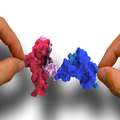New insights into processes vital to cellular functions and human health:
Physicists manipulate single molecules to unravel secrets of protein folding
27.10.2011, Press releases
Physicists at the Technische Universitaet Muenchen (TUM) are opening a new window into the life of biological cells, using a technique that lets them grab the ends of a single protein molecule and pull, making continuous, direct measurements as it unfolds and refolds. Their latest results, reported in the journal Science, reveal a complex network of intermediate structural and kinetic states along the way to functionally correct folded forms, including both express routes and dead ends. Better understanding of protein folding is essential because incorrectly folded proteins cause diseases such as Alzheimer's and Parkinson's. The experiments focused on the protein calmodulin, which is not implicated in these diseases but plays a role in many processes vital to cellular functions, and thus to human health.
The functions (and malfunctions) of proteins are largely determined by their structures, so researchers are exploring many avenues toward understanding precisely how they fold (or misfold). Where X-ray structural analyses offer "snapshots" of protein folding, single-molecule force spectroscopy -- the approach pioneered by Prof. Matthias Rief and colleagues in the TUM Department of Physics -- produces views that are, by comparison, more like movies. Even though these movies are very "blurred," since they only capture the length of the molecule, they allow the researchers to study the dynamics of the folding process.
In the study reported in Science, Rief's co-authors were TUM doctoral candidates Johannes Stigler, Fabian Ziegler, Anja Gieseke, and Christof Gebhardt (now a postdoc at Harvard University). A grant from the TUM Institute for Advanced Study helped the laboratory acquire the instrumentation that made these single-molecule experiments possible -- ultra-stable, high-resolution "optical tweezers," a tool that traps miniscule objects between opposing laser beams as surely as if they were being held between thumb and forefinger.
To get a grip on a calmodulin molecule, the researchers first would insert it between two molecules of a mechanically tougher protein called ubiquitin. Residues of the amino acid cysteine at the outer ends of this assembly allowed "handles" made of DNA to be attached, and these were fixed to glass beads one micrometer in diameter. The beads, and thus the calmodulin molecule between them, could then be manipulated with the optical tweezers. The essence of the experiments, repeated many times over in a variety of ways, was to pull the ends of a single, folded calmodulin molecule until it straightened out and then to reduce the tension so it could fold again, constantly measuring protein length, mechanical forces and time with extreme precision. Throughout, the calmodulin molecule was kept in conditions not too different from its working environment inside a cell, an aqueous solution with a concentration of calcium ions known to favor stable folding. Statistical analysis helped to reveal what the measurements recorded.
The results indicate that distinct subdomains of the calmodulin molecule fold independently yet interact with others, sometimes cooperating and sometimes interfering. "Far from being a simple two-state process," Rief explains, "the folding of a calmodulin molecule takes place via a complex network of pathways in what we call its 'energy landscape.' We found that this map of kinetic states and paths between different folded forms includes dead ends -- intermediate structures that need to be undone, like unwanted knots in a rope, before the protein can assume a shape that enables it to function properly." The researchers also discovered express routes, pathways that let some domains reach their final state much more rapidly than the molecule as a whole.
"The calmodulin molecule," Rief says, "even though considered small compared to most proteins in our body, already exhibits unexpected complexity in its folding. Nature manages to fold much more complex proteins without major misfoldings. Understanding this still remains a challenge for the future, and single-molecule experiments will help to resolve it."
This research was supported by the Deutsche Forschungsgemeinschaft (SFB 863 A2), the TUM Institute for Advanced Study (Excellence Initiative), and the Elite Network of Bavaria.
Original publication:
The Complex Folding Network of Single Calmodulin Molecules
Johannes Stigler, Fabian Ziegler, J. Christof M. Gebhardt, Matthias Rief
Science, Oct. 28, 2011, pp. 512-516
DOI: 10.1126/science.1207598
Contact:
Prof. Matthias RiefDepartment of Physics E22
Technische Universitaet Muenchen
James-Franck-Strasse 85748 Garching, Germany
Tel: +49 89 289 12471
E-mail - Home page
Kontakt: presse@tum.de
More Information
| 111027_FoldingNet_Rief_EN_PW.pdf |
Printable version of the press release (EN),
(Type: application/octetstream,
Size: 109.4 kB)
Save attachment
|
|
| 111027_Calmodulin_DE_PW.pdf |
Druckversion der Presseinformation (DE),
(Type: application/octetstream,
Size: 106.6 kB)
Save attachment
|




